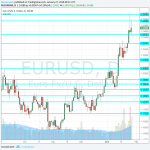High Valuations & Exuberance Are The Main Bearish Arguments
The best argument the bears have is valuations are too high as the stock market continues going up. Personally, I can’t see stocks falling with this type of earnings momentum and economic growth. That being said, the Shiller PE is at 31.9 which is close to the peak in 1929. I don’t buy the argument that the Shiller PE could be lower when the earnings in 2008 are lapped out of the 10 year metric because the entire point of the Shiller PE is that it uses actual earnings results. If you start taking into account the projections, it becomes a forward multiple which isn’t the point of the metric. Keep in mind, that the 2008 earnings are fully out of this metric in the spring of 2019; that’s still far off in the distance.
Besides high valuations, the other issue is the heightened exuberance in the market. I would call this rational exuberance because investors have reason to be exited as the S&P 500 has record earnings and the economy in 2017 might grow close to 3%. Staying in tune with this point of rational exuberance, the chart below shows the U.S. household and non-profits’ exposure to equities. As you can see, the exposure in 2017 is near the peak in 2007. In the next few months, it will probably surpass that peak. The only other period with higher exposure was the bubble in the 1990s. Given the heightened speculation in cryptocurrencies, I expect the equity exposure will never get to the 1990s levels because the real speculation is occurring in cryptos, not stocks. I think cryptos have a while to run because their total size is dwarfed by just one of the tech giants in the 1990s, but that’s a discussion for another article.

Yield Curve & Personal Savings Additional Arguments
The next argument that the bears have is the flattening yield curve. Currently, there isn’t much of an argument because it isn’t inverted. However, it is slightly disconcerting to see how it is quickly flattening while such great economic reports come out. It’s possible that the yield curve is flattening because of the fast growth. The economy is moving from the Goldilocks scenario to overheating. It’s not there yet, but inflation usually comes after growth accelerates. The yield curve tells me growth will accelerate in 2018, causing inflation. Then a recession will occur in 2019 or 2020. Given that perspective, there’s nothing negative that the yield curve is saying just yet. The chart below compares the yield curve to the real disposable income growth per capita. Not surprisingly, inversions forecast declines in real disposable income. I’m expecting real disposable income to increase in 2018 because of wage growth. However, that can change by the end of the year because inflation might pick up.
















Leave A Comment